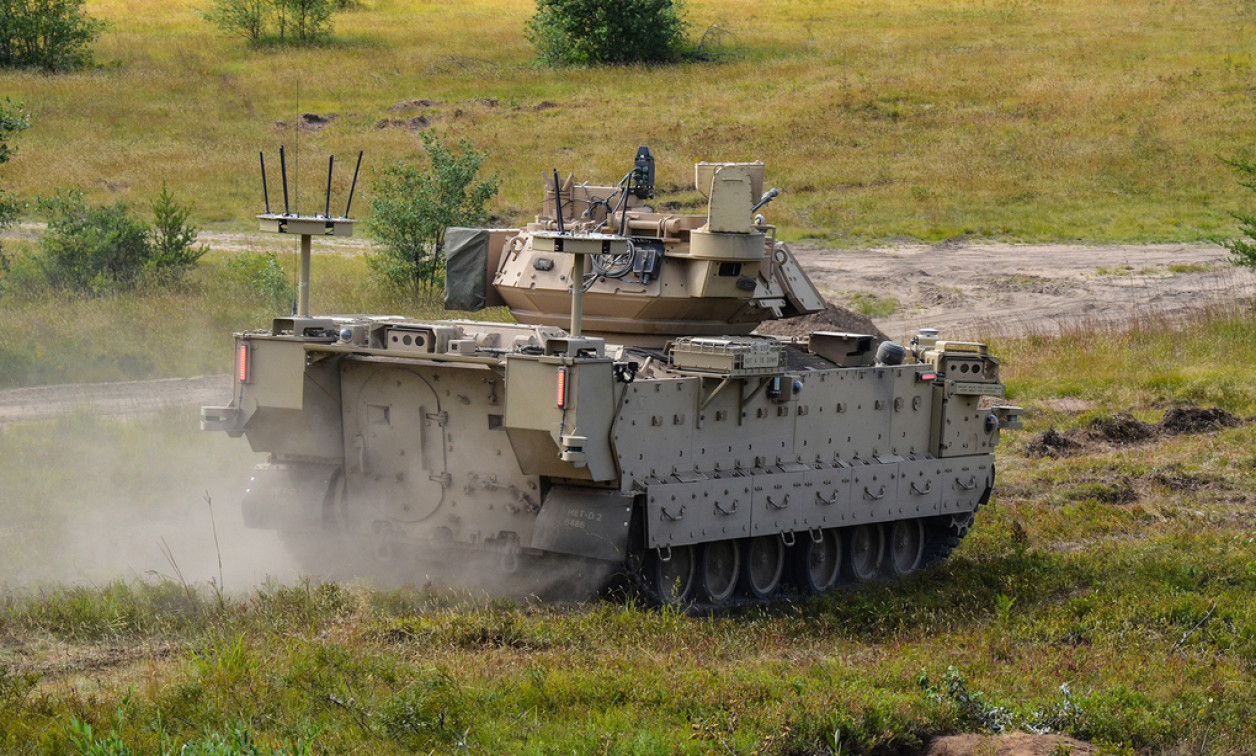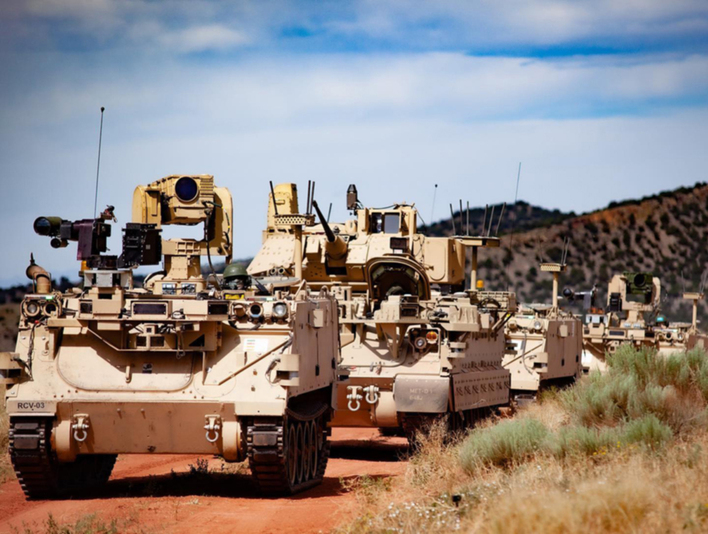The case for distributed and remote management of open standards-based tactical networks for vehicles
StoryNovember 19, 2020

By David Gregory and Jeff Nelson
To exploit the potential benefits of new technologies such as artificial intelligence (AI), robotics, video analysis, Internet of Things (IoT), augmented reality and virtual reality, and other innovative technologies on mobile platforms at the tactical edge, Department of Defense (DoD) communications programs must effectively deploy advanced IT infrastructure, connectivity, and compute resources. The Army understands this need: It is investing in research, standardization, and demonstration to ensure that future vehicle networks deliver these benefits while minimizing cost, enabling rapid fielding, and facilitating ongoing modernization. These moves also leverage modular, open standards-based COTS [commercial off-the-shelf] technologies.
The Army’s Next Generation Combat Vehicle (NGCV) Cross Functional Team created the Mission Enabling Technology Demonstrator (MET-D) as part of the effort to deploy advanced mobile IT infrastructure. MET-D is a cutting-edge experimental system of vehicles developed to help Army leaders determine how best to integrate unmanned robotic vehicles, advanced networking technologies, and future sensor capabilities into ground combat formations. MET-D provides a look forward 10 to 20 years into the future of what military operations may look like, with the primary objective of reducing risk to soldiers.
For example, MET-D platforms leverage the latest sensor technology, data display, consolidated capabilities, modular open standards, innovative graphical user interfaces, drive-by-wire capabilities, unmanned aerial vehicle (UAV) surveillance video, and advanced communications systems. The MET-D manned fighting vehicle (MFV) can remotely operate robotic combat vehicles (RCV) designed to make contact with the enemy before soldiers do, while simultaneously providing overmatch against additional operating environment threats.
The NGCV and the Army Ground Vehicle Systems Center (GVSC) have begun experiments to prove and refine concepts. This approach is illustrated by soldier operational experiments conducted earlier in 2020 to “observe, collect, and analyze feedback from soldiers to assess the feasibility of integrating unmanned vehicles in ground combat formations,” according to information from the U.S. Army, and to determine if ground-combat-unit lethality can be enhanced through robotic combat vehicles. (Figure 1.)

[Figure 1 | In July 2020, cavalry scouts from the U.S. Army Comanche Troop 4th Squadron, 10th U.S. Cavalry Regiment, became the very first U.S. Army soldiers – along with the Army’s Ground Vehicle Systems Center (GVSC) and Next Generation Combat Vehicle (NGCV) Cross Functional Team – to begin Phase 1 testing of robotic warfighting vehicles designed to limit risk to soldiers. Photo courtesy of GVSC.]
These new platforms are also designed to enable experiments and developments around additional changes such as cyber resiliency, defined as the ability to anticipate, withstand, recover, and adapt to adverse electronic warfare (EW) conditions, attacks, or compromises. Disruptions to these networks – whether from attacks or simple human error – will be costly and have adverse effects on the warfighter who increasingly relies on advanced technologies for mission success.
Next-generation technology will surely increase bandwidth requirements of the underlying network across battlefield domains, placing additional needs for communication link reliability and driving the Army to experiment with many new types of data transmission.
Advancing technology drives need for open standards
These new technologies hold great promise to deliver increased safety and lethality for the warfighter and offer commanders new options for maneuvers. However, the Army faces the daunting process of integrating a vast suite of rapidly advancing technologies. The Army believes that current methods of technology integration are reaching the end of their usefulness, won’t scale, are unaffordable, and will require too much space, weight, and power in the future – particularly as the array of new technologies comes online and needs to be deployed.
The Army also understands that in order to “future-proof” new generations of vehicles, as well as to make existing platforms upgradable as technology continues to advance, it needs to enforce open standards-based architectures. This approach enables incremental upgrades of individual technologies while maintaining interoperability, functionality, and cybersecurity.
To this end, the Army is making significant efforts, in collaboration with industry and other services, in developing comprehensive “standards-based communications” to overcome hardware and software interoperability issues, define modularity standards, characterize databus functionality, and standardize messaging services for interconnected system components. In 2019, the Army, Navy, and Air Force signed a memorandum to develop a Modular Open Systems Approach (MOSA) that includes a number of key subsets such as:
- Sensor Open Systems Architecture (SOSA): A unified technical open systems architecture standard for radar, EO/IR [electro-optical/infra-red], SIGINT, EW, and communications.
- C4ISR/EW Modular Open Suite of Standards (CMOSS): A suite of industry open architectures and U.S. Army standards targeted at reducing C5ISR system size, weight and power (SWaP), and ensure commonality across diverse platforms.
- Vehicular Integration for C4ISR/EW Interoperability (VICTORY): Provides network-based interoperability using shared services such as position and time.
- OpenVPX: A hardware form factor for fielding capabilities such as plug-in cards in a common chassis.
- Modular Open RF Architecture (MORA): Drives functional decomposition so resources can be shared, such as antennas and amplifiers.
- Software frameworks: Includes REDHAWK, Software Communications Architecture (SCA), and Future Airborne Capability Environment (FACE) to enable software portability.
The goal of these standards, taken together, is to create a system of modular electronics and software components that reduce SWaP, enable multiple industry partners to interoperate, allow for incremental modernization of components, reduce cost, and deploy new advanced technologies without requiring entire system redesigns.
This modular electronics approach is designed to transition vehicles from using separate stovepiped boxes to instead employing integrated, high-density chassis with standardized interfaces improving maintainability (making it easier and more cost-effective to upgrade capabilities), reducing complex integration challenges, and increasing industry competition.
Increasingly rapid fielding and technology density leads to management complexity
The developing standards outlined above will enable organizations to deploy more technology onto smaller platforms. This reality will drive the need to address a critical side effect: added complexity, maintenance, and training.
These new technologies, combined with an already increasingly difficult-to-manage IT infrastructure at the tactical edge, runs the risk of becoming unusable simply due to its complexity. This dynamic is well understood in enterprise IT organizations that work hard to centralize, standardize, and automate complex management, monitoring, and configuration tasks. These challenges are much more difficult in ad-hoc, distributed, intermittently, or poorly connected networks in dynamic environments.
Additionally, the burden of maintainability never gets less expensive or unwieldy as prototypes and proof-of-concepts transition to production networks. As the innovation life cycle continues to introduce more capability, the maintenance tail requires more training, configuration management, testing; all of these equal additional processes to manage.
Taming management complexity of open standards-based vehicle networks
The management challenges of the MET-D experimental architecture are likely to continually increase as the system capability and complexity evolves, all of which mean definite modernization and usability challenges.
A solution to sustain MET-D’s modernization efforts is to consolidate and simplify MET-D’s network visualization, device integration, and configuration management on vehicles – using open standards software and network-management interfaces – into a single user interface that enables tailorable access to the configuration items and information appropriate for the types of operators using the systems. This kind of solution can consolidate dozens, or even hundreds, of diverse screens that would otherwise be presented to operators and administrators, by underlying technologies each developed by a different vendor. It can also let programs experiment with new technologies while maintaining a consistent user interface, even across upgrades.
The demonstrations should also include capabilities to enable Remote Operations and Management (ROAM) for MET-D’s relevant tactical networks to ensure the manageability of these systems at real-world scale. Remote management of multiple platforms requires network visualization, node status and management, support for cybersecurity administration, configuration management, and aggregated node reporting. This approach will enable robust operational support from upper echelons and aid in situational awareness while driving down complexity, downtime, and configuration errors.
Distributed software management technology – running locally on each node – is necessary to efficiently achieve ROAM functionality and consolidate the management plane of the network. This awareness must extend from the upper echelons to the edge of the tactical networks; the technology must operate seamlessly in disconnected, intermittent, and limited (DIL) environments. A robust ROAM solution deployed on each node can support collaborative management between local on-platform, lightly trained, or untrained crew members; on-platform administrators; and remote highly trained administrators who might be in DIL situations.
In summary, while moving forward on increasing technical capabilities at the edge, it is necessary to simultaneously consider a robust communications management software solution for remote operations and management to maximize the effectiveness of MET-D networks. This move will consolidate the management plane of networks onto a unified interface regardless of the type of technology or vendor. It will be capable of providing distributed, hierarchical, and efficient management of network-attached nodes.

David Gregory, senior solutions architect at PacStar, develops advanced capabilities working closely with industry partners to identify and productize new technologies and integrated solutions. David has extensive experience developing products and solutions for the DoD, with a technical background in electrical engineering, computer engineering, digital design, CSfC (Commercial Solutions for Classified), and ISR (intelligence, surveillance, and reconnaissance) – including experience developing and fielding tactical networking solutions for the DoD and intelligence community.

Jeff Nelson, senior business development manager at PacStar, has been in the business of improving warfighter tactical communications for more than 30 years. His experience includes Communications Officer (“CommO”) in the Marine Corps, satellite communications and tactical radio portfolio manager, project manager at HQDA CIO/G6, satellite gateway project manager at DISA, and intelligence-community communications specialist. His graduate thesis, focused on space segment internetworking, provides a space-based strategy for Primary, Alternate, Contingent, and Emergency (PACE) communications architectures. Jeff’s current position allows him to help program managers and operational customers integrate cutting edge technology to improve “shoot, move, and communicate”; enhance network situational awareness; reduce size, weight, and power (SWaP); and improve mission command efficiency down to the platform level.
PacStar • https://pacstar.com






